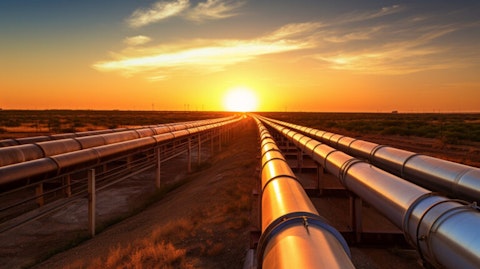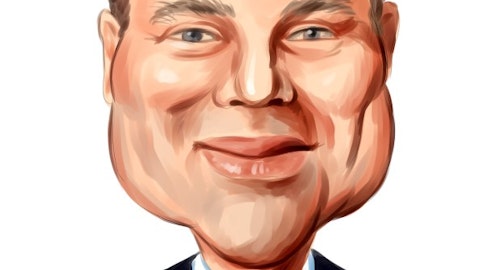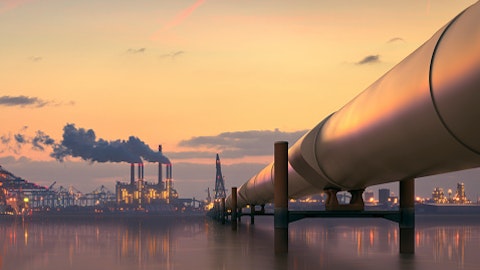MPLX LP (NYSE:MPLX) Q3 2023 Earnings Call Transcript October 31, 2023
MPLX LP beats earnings expectations. Reported EPS is $0.927, expectations were $0.91.
Operator: Welcome to the MPLX Third Quarter 2023 Earnings Call. My name is Sheila, and I will be your operator for today’s call. At this time, all participants are in a listen-only mode. Later, we will conduct a question-and-answer session. [Operator Instructions] Please note that this conference is being recorded. I will now turn the call over to Kristina Kazarian. Kristina, you may begin.
Kristina Kazarian: Thank you, Sheila. Good morning, and welcome to the MPLX third quarter 2023 earnings conference call. The slides that accompany this call can be found on our website at mplx.com under the Investors tab. Joining me on the call today are Mike Hennigan, Chairman and CEO; John Quaid, CFO; and other members of the executive team. We invite you to read the safe harbor statements and non-GAAP disclaimer on Slide 2. It’s a reminder that we’ll be making forward-looking statements during the call and during the question-and-answer session that follows. Actual results may differ materially from what we expect today. Factors that could cause actual results to differ are included there as well as in our filings with the SEC. With that, I’ll turn the call over to Mike.

The sun rising over a sprawling network of oil & gas pipelines near Midland, Texas.
Michael Hennigan: Thanks, Kristina. Good morning, everyone. Thank you for joining our call. Earlier today, we reported third quarter adjusted EBITDA of $1.6 billion and distributable cash flow of $1.4 billion, each set a new quarterly record for MPLX with both increasing over 8% year-over-year. Our L&S business set a new record for crude pipeline throughput and saw strong terminal throughputs, demonstrating the value of our relationship with MPC. In our G&P business, we saw record throughput in our processing and fractionation operations driven mainly by our assets in the Permian and Marcellus basins. Our long-term production outlook for our G&P producer customers in our key basins remains largely unchanged. In our largest basin, the Marcellus, the cost to develop remains at the low end of the cost curve and still below current commodity prices, we expect to see maintenance level drilling activity continue.
While in the Permian, crude prices remained strong and prices for associated gas do not significantly impact producer activity. Our integrated footprint in these basins position the partnership with a steady source of growth opportunities. For the second year in a row, based on the strength and continued growth of our cash flows, last week, we announced a 10% increase in the partnership’s distribution, which now stands at $3.40 per unit on an annualized basis. We’re committed to returning capital to unitholders and expect our distribution to be the primary return of capital tool supplemented with opportunistic repurchases. We are well positioned to optimize return of capital given the strength of the business and our balance sheet. Our position on MPLX and its structure is unchanged.
MPLX is a strategic investment for MPC, which now expects to receive $2.2 billion in annual cash flows via the distribution. MPC believes that its current capital allocation priorities are optimal for its shareholders and MPC does not plan to roll up MPLX. We remain confident in our ability to grow the partnership and our focus on executing the strategic priorities of strict capital discipline, fostering a low-cost culture and optimizing our asset portfolio, all of which are foundational to the continued growth of MPLX’s cash flows. Now let me turn the call over to John to discuss our growth as well as our operational and financial results for the quarter.
John Quaid: Thanks, Mike. As you can see on Slide 5, MPLX has a strong history of growing its cash flows by executing the strategic priorities Mike just highlighted. Looking back over the last 3 years, you can see that our growth comes in stair steps as we develop and bring projects online. And through the first 9 months of this year, distributable cash flow has grown over 6% versus the prior year. We are progressing our 2023 capital program, which remains forecasted at $950 million, including $800 million of growth capital and $150 million of maintenance capital. In the L&S segment, our joint venture natural gas, crude and NGL pipeline projects in the Permian are progressing. Whistler’s expansion, the 2.5 billion cubic feet per day was completed at the end of the third quarter, and we’re seeing strong demand for the natural gas pipeline.
Construction is progressing on the associated Agua Dulce Corpus Christi Pipeline lateral, which is expected to be in service in the third quarter of 2024. On the Wink to Webster crude pipeline, we expect volumes to ramp over the next 2 years as the pipeline continues to play segments into service. Turning to our participation in the NGL value chain. We are progressing the expansion of the BANGL pipeline to about 200,000 barrels per day, which is expected to be completed in the first half of 2025. The capital-efficient expansion of this long-haul pipeline is supported by existing and growing demand for NGL takeaway from the Permian’s Delaware and Midland Basins to the fractionation hub in Sweeny, Texas. All of these projects are largely financed at the JV level, and therefore, our portion of the JV finance capital spending is not reflected in our capital outlook.
In the G&P segment, we remain focused on growth investments in the Permian and Marcellus basins in response to producer demand. We are bringing online new gas processing plants in the Permian Delaware Basin to meet increasing demand while targeting strong returns with strict capital discipline. We’re progressing construction of Preakness II, which we expect to be online in the first half of 2024. And announced last quarter, we would be building our seventh gas processing plant in the basin Secretariat, which is expected to be online in the second half of 2025. Once operational, these plants will bring our total processing capacity in the Delaware Basin up to 1.4 Bcf per day. In the Marcellus Basin, we are also advancing construction of the Harmon Creek II gas processing plant, which we expect will be online in the first half of 2024.
Slide 6 outlines the third quarter operational and financial performance highlights for our Logistics & Storage segment. The L&S segment reported its third consecutive quarter with $1 billion of adjusted EBITDA. L&S segment adjusted EBITDA increased $122 million when compared to third quarter ’22, primarily driven by higher rates and throughputs, including growth from equity affiliates. Third quarter 2023 segment adjusted EBITDA excludes Garyville incident response cost of $63 million. Crude pipeline volumes were up 9% and represent a new quarterly record for the partnership as we grew crude oil throughputs through expansion and debottlenecking activities. Product pipeline volumes were down 9%, driven by less favorable market dynamics and effects from Marathon’s refinery downtime.
Terminal volumes were up 7% due to higher customer demand, including effects from Marathon’s refinery turnarounds in both quarters. Looking ahead to the fourth quarter, we do expect some headwinds of approximately $30 million to $40 million to sequential L&S segment results from lower throughput volumes as a result of MPC’s planned turnaround activity, as well as higher operating expenses due to the timing of maintenance projects. Moving to our Gathering & Processing segment on Slide 7. G&P segment adjusted EBITDA increased $3 million compared to third quarter 2022 as the benefits of higher volumes and throughput fees were offset by lower NGL prices. While our G&P segment is largely a fee-based business, we do have some direct sensitivity to natural gas liquids prices.
For the quarter, NGL prices averaged $0.68 per gallon as compared to $1.01 in the third quarter of 2022, resulting in a $32 million unfavorable effect. Total gathered volumes were up 3% year-over-year due to increased production in the Permian and the Marcellus. Processing volumes were up 5% year-over-year, primarily from higher volumes in the Marcellus and Permian, driven by increased customer demand and our investment in Permian processing capacity. Focusing in on the Marcellus, by far, our largest basin of operations, we saw year-over-year volume increases of 4% for gathering and 5% for processing, driven by increased customer demand and fractionation volumes grew 10%, primarily due to increases to our fractionation capacity to meet in-basin demand for ethane.
Moving to our third quarter financial highlights on Slide 8. Total adjusted EBITDA of $1.6 billion and distributable cash flow of $1.4 billion increased 8.5% and 8.6%, respectively, from the prior year. As Mike discussed, based on our confidence in the continued growth of our cash flows, we increased the base distribution 10% to $0.85 per common unit while maintaining strong coverage of 1.6 times. We are committed to returning capital to unitholders and year-to-date we have returned $2.4 billion through our distributions. Our capital allocation framework remains unchanged, and we continue to expect the distribution will be our primary tool to return capital. Opportunistic repurchases of units held by the public also remain a tool to supplement capital returns.
The growth of our cash flows and our strong balance sheet, including a quarter end cash balance of $960 million and leverage of 3.4 times, provides us with financial flexibility to optimize capital allocation. Now let me hand it back to Mike for some final thoughts.
Michael Hennigan: Thanks, John. In closing, the growth of our cash flows continues to enable us to invest in and grow the business while supporting our commitment to return capital to unitholders. We continue to expect our distribution to be the primary return of capital tool. And with the recently announced 10% increase to the partnership’s base distribution, MPC now receives $2.2 billion annually from MPLX’s distributions, illustrating its strategic value as part of MPC’s portfolio. As MPLX pursues its growth opportunities, we believe the value of this strategic relationship will continue to be enhanced. We are confident in our growth opportunities and ability to generate strong cash flows. By advancing our high-return growth projects anchored in the Marcellus and Permian Basins, along with our focus on cost and portfolio optimization, we intend to grow our cash flows, allowing us to reinvest in the business and return capital to unitholders.
Now let me turn the call back over to Kristina.
Kristina Kazarian: Thanks, Mike. As we open the call for questions, we ask that you limit yourself to one question plus a follow-up. We may re-prompt for additional questions as time permits. And with that, Sheila, we’re ready for the questions today.
See also 14 Most Undervalued Healthcare Stocks To Buy According To Hedge Funds and 12 Best Micro Cap Stocks To Invest In.
Q&A Session
Follow Mplx Lp (NYSE:MPLX)
Follow Mplx Lp (NYSE:MPLX)
Operator: Thank you. We will now begin the question-and-answer session. [Operator Instructions] Our first question comes from John Mackay with Goldman Sachs. Your line is open.
John Mackay: Good morning, everyone. Thanks for the time. I wanted to start on maybe the distribution increase last week. Maybe if you could just frame up for us how you were thinking about the 10% level, what that kind of means for cadence going forward? And if you could kind of touch about – touch on that in the context of leverage now being down at 3.4 [ph] versus the 4.0 [ph] ceiling? Thanks.
John Quaid: Hey. Good morning, John. Thanks for the question. Yes, I think it all gets down to we’ve got a significant amount of financial flexibility here. I think as you can see where we stand as we’ve been very focused around our capital allocation to growth, but also making sure we’re returning capital to unitholders. As you know, we’ve talked in the past, we stay very focused on where our coverage is and digging into that, very comfortable here with this increase staying at 1.6 times, certainly some capacity there. Again, very happy where the balance sheet is. But I think, as I think about – I’m sure Michael has some comments as well. I mean, that’s not just return of but also looking for opportunities to invest and drive return on capital as well. So I think we’re in a very comfortable spot. Happy to do 10% for the second year in a row and continue to be focused on both growing the partnership and also driving returns to unitholders.
Michael Hennigan: And John, it’s Mike. I’ll just add that the way we think about it from an investor perspective is, at the end of the day, we’re trading around a 9% yield roughly, and we’ve been saying to the market. And I think we’ve demonstrated in our results, we’re going to continue to grow earnings somewhere around that mid-single digit. It will be a little stairsteppy. But if you look at our CAGR since 2019, it’s been a little north of 6%. So as I think about the investment opportunity for people, our yield plus growth should give a pretty strong opportunity for people to invest in the equity. And the way we think about it, as John just said, is we’re thinking about this over the longer term. We have a lot of financial flexibility right now.
We have cash on the balance sheet, which is both blue bar and red bar. So we have more distribution growth capable. We have opportunistic capabilities. If we see more volatility come back into the equity, which we haven’t seen for a little bit of time, but we’ll see how that changes. But overall, we’re trying to position ourselves as a good investment for people that are interested in the type of cash flows that we’re generating. So hopefully, that gives you some perspective as the way to think about it from an investor angle.
John Mackay: I appreciate that. Thanks. And maybe picking up on the themes of continuing to invest in the business, obviously, reiterated growth CapEx guidance for the year. We’ve also seen – I think if we look at third quarter, growth CapEx came in a little lighter than we would have been than we expected. Maybe you can just talk about the cadence of growth spending from here, where opportunities might sit beyond the project backlog you’ve announced so far? Thanks.
John Quaid: Yes. Thanks, John. I’ll jump in on that one. I think as we’ve said before to it, our capital doesn’t – right, it tends to move quarter-to-quarter. So you’re not going to see kind of ratable amounts again here this morning. We stated again, we’re still looking around that $800 million of growth capital for this year. And again, in my remarks and on Slide 5, we’ve tried to summarize kind of the major projects we’re working towards. We’ve got two processing plants, one in the Marcellus, one in the Permian, coming online in the first half of next year. We announced last quarter another processing plant in the Permian, which will be out in 2025, right? So you’ll probably start to see us spend some money on that. And then we’ve got a number of the different JV pipeline projects that we’re progressing as well.
So again, I think you’ve asked before and we’ve said, hey, that plus or minus $1 billion of kind of run rate CapEx is probably a comfortable zone for us. And I think the opportunities kind of remain in those main basins. And then also, too, we also continue to look for opportunities around our large L&S footprint in support of MPC, where there are opportunities for us to find smaller bolt-on acquisitions where we can operate a midstream asset and MPC can commercially create value around that.
Operator: Thank you…
John Mackay: Appreciate the time. Thank you.
John Quaid: Thanks, John. You’re welcome.
Operator: Our next question will come from Theresa Chen with Barclays. You may proceed.
Theresa Chen: Good morning. Thank you for taking my question. John, maybe if I can touch on your last point about potential bolt-on acquisitions, especially at the asset level. We’ve received multiple announcements from some of your competitors and peers about wanting to disperse assets into the market. Are there particular areas along your infrastructure value chain that you find more attractive to invest in, given what’s out in the market from companies today as well as potentially a piece of TMX later on?
John Quaid: Theresa, I’ll maybe ask Dave to chime in on that one.
David Heppner: Theresa. So this is Dave. So yes, that’s a great question. So as we look at opportunities to pursue, number one, we always look into high-quality assets that are aligned with our long-term strategies. And also provide the ability to integrate and capture synergies along our value chains, mainly around crude, nat gas and NGLs and also finally, of course, is a return of capital – return on capital, I’m sorry. They always have to give us the appropriate acceptable risk-adjusted return. So I think as you think through that, it’s really – there’s a lot of M&A out there, as you stated. We continue to look at them, but we’re looking through the lens of strict capital discipline on those key tenants, high-quality assets and synergies and integration value. So that’s kind of how we’re thinking through it.
John Quaid: And Theresa, it’s John again. Maybe just to add on to that with some examples. And again, these are what we like to call kind of singles, maybe they’re even bunts [ph] But – earlier this year, we were able to acquire some boats and barges to expand our marine fleet to provide increased flexibility to MPC on moving product. Last year, we had a rail facility near our Dickinson MPCs, Dickinson refinery that MPLX was able to acquire to move product there too. So that’s the piece is that value of interacting with our sponsor or again, we can kind of find those. So I’d say it’s across, as Dave said, that whole value chain, where do we – those are assets we know how to run and operate, and we’ve got a customer that needs them too. So I’d say it’s around those kind of examples as well. Mike, did you want to…
Michael Hennigan: Yes. Theresa, I’m going to add on to John’s comment there. So obviously, on the calls, people like to hear big sexy [ph] projects, and that’s not been our forte. But we have been investing in smaller – where we get a really good return for a little to no capital. As an example, we had record crude throughput it’s not sexy to come out and say we added a pump here or something along those lines, but where you can deploy small amounts of capital and get large returns, we think those are really great opportunities for us. And the magnitude of the size of our asset base enables Shawn’s team and Greg’s team to look throughout all of our assets and come back. And even though the total capital number seems to some people to say, how are you getting this growth?
Well, part of it is because we’re getting some really good returns out of that deployment. And to me, that’s part of the game that we’re trying to do is get the highest possible returns out of the lowest capital deployment. And at the end of the day, to me, it still comes down to are you generating cash flows. And we feel very confident that at the end of the day, our cash flow generation is showing a consistent pattern that we think investors should find appealing. Hopefully, that’s answering your question in a little bit more detail.



